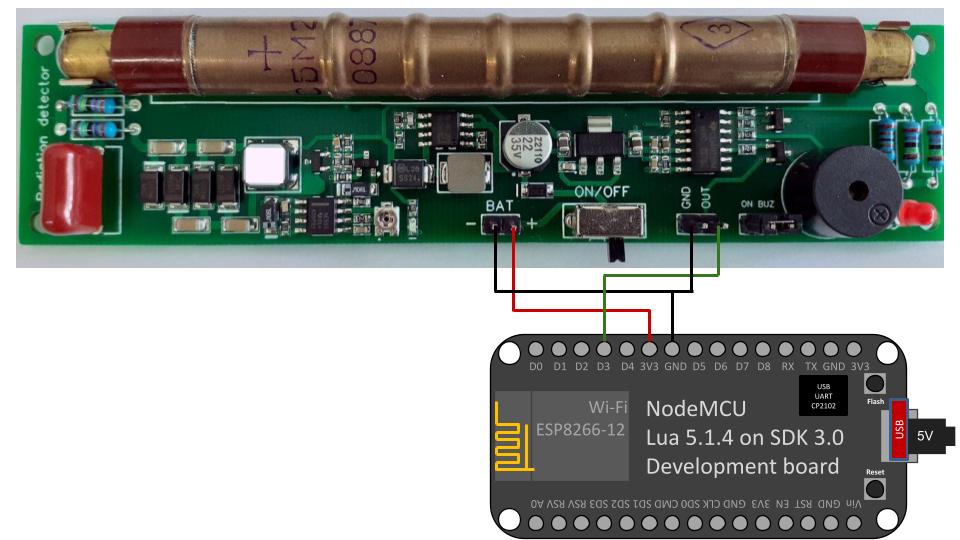IoT-devices GGreg20_V3 module
GGreg20_V3 Ionizing radiation detector module
Geiger-Mueller tube: SBM20
Input voltage: 2.2V - 5.5V
Tube Voltage: 400V
Sensor-side interface: pulse output
MCU-side interface: GPIO with pulse counter
GGreg20_v3 is compatible with the ESP8266/ESP32 logic signal levels (3V3 ACTIVE-LOW: 3.0-3.3V HIGH and about 0.7V LOW), and will work even with the 5V logic input. Sensor compatibility: any ESP8266- or ESP32- powered device
Vendor site: https://allmylinks.com/iot-devices
Connection
For example, it could be GPIO0 (D3). This pin is convenient because it has a built-in Flash button in most devices and boards based on the ESP8266 module - in case you need to check how the controller counts pulses without a sensor, it is possible to simulate pulses with a button.
Powering from a 2.4V input source
If you want to power the GGreg20_V3 from a 2.4 volt source, you need to short the Schottky diode shown in the photo with
a wire or replace it with a 0 ohm resistor. Note, however, that such a correction will disable the module's reverse
polarity protection:

Basic Configuration
esphome:
name: esphome_node1 # Controller Unique Name
esp8266:
board: nodemcuv2 # Controller type you have to select when creating new yaml-config in ESP Home
wifi:
ssid: "YourWiFiSSID"
password: "SSIDPassword"
# Enable fallback hotspot (captive portal) in case wifi connection fails
ap:
ssid: "Esphome Node1 Fallback Hotspot"
password: "Cpxg9hRIBU7M"
captive_portal:
# Enable logging
logger:
# Enable Home Assistant API
api:
encryption:
key: !secret encryption_key
ota:
password: "OTApassword"
# Just embedded test D3 (GPIO0) button on every ESP8266 Devboard
# You can press D3 button several times to simulate incoming GGreg pulses
binary_sensor:
- platform: gpio
name: "D3 Input Button"
pin:
number: 0
inverted: True
mode: INPUT_PULLUP
# Here we calc and include to the firmware a power and doze values of ionizing radiation as sensor outputs
sensor:
- platform: pulse_counter
pin: D3
unit_of_measurement: "mkSv/Hour"
name: "Ionizing Radiation Power"
count_mode:
rising_edge: DISABLE
falling_edge: INCREMENT
update_interval: 60s
accuracy_decimals: 3
id: my_doze_meter
filters:
- sliding_window_moving_average: # 5-minutes moving average (MA5) here
window_size: 5
send_every: 5
- multiply: 0.0054 # SBM20 tube conversion factor of pulses into mkSv/Hour
- platform: integration
name: "Total Ionizing Radiation Doze"
unit_of_measurement: "mkSv"
sensor: my_doze_meter # link entity id to the pulse_counter values above
icon: "mdi:radioactive"
accuracy_decimals: 5
time_unit: min # integrate values every next minute
filters:
- multiply: 0.00009 # obtained doze (from mkSv/hour into mkSv/minute) conversion factor: 0.0054 / 60 minutes = 0.00009; so pulses * 0.00009 = doze every next minute, mkSv.
